weight MAZDA MODEL 3 HATCHBACK 2020 Owners Manual (in English)
[x] Cancel search | Manufacturer: MAZDA, Model Year: 2020, Model line: MODEL 3 HATCHBACK, Model: MAZDA MODEL 3 HATCHBACK 2020Pages: 598, PDF Size: 89.37 MB
Page 44 of 598
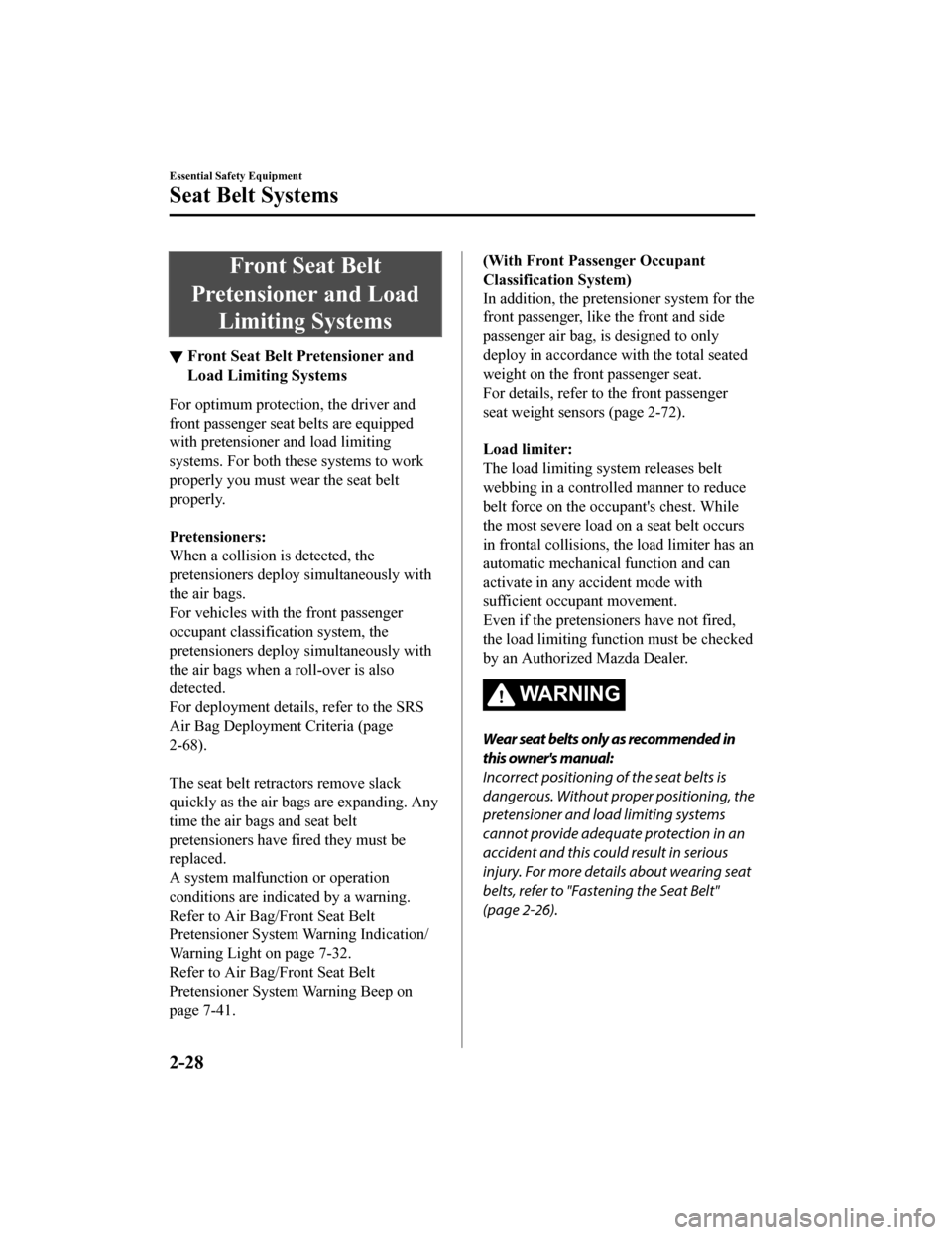
Front Seat Belt
Pretensioner and Load Limiting Systems
▼Front Seat Belt
Pretensioner and
Load Limiting Systems
For optimum protection, the driver and
front passenger seat belts are equipped
with pretensioner and load limiting
systems. For both these systems to work
properly you must wear the seat belt
properly.
Pretensioners:
When a collision is detected, the
pretensioners deploy simultaneously with
the air bags.
For vehicles with t he front passenger
occupant classification system, the
pretensioners deploy simultaneously with
the air bags when a roll-over is also
detected.
For deployment details, refer to the SRS
Air Bag Deployment Criteria (page
2-68).
The seat belt retractors remove slack
quickly as the air bags are expanding. Any
time the air bags and seat belt
pretensioners have fired they must be
replaced.
A system malfunction or operation
conditions are indicated by a warning.
Refer to Air Bag/Front Seat Belt
Pretensioner System Warning Indication/
Warning Light on page 7-32.
Refer to Air Bag/Front Seat Belt
Pretensioner System Warning Beep on
page 7-41.
(With Front Passenger Occupant
Classification System)
In addition, the pretensioner system for the
front passenger, like the front and side
passenger air bag, is designed to only
deploy in accordance with the total seated
weight on the front passenger seat.
For details, refer to the front passenger
seat weight sensors (page 2-72).
Load limiter:
The load limiting system releases belt
webbing in a controlled manner to reduce
belt force on the occupant's chest. While
the most severe load on a seat belt occurs
in frontal collisions, th e load limiter has an
automatic mechanical function and can
activate in any accident mode with
sufficient occupant movement.
Even if the pretensioners have not fired,
the load limiting function must be checked
by an Authorized Mazda Dealer.
WA R N I N G
Wear seat belts only as recommended in
this owner's manual:
Incorrect positioning of the seat belts is
dangerous. Without pr oper positioning, the
pretensioner and load limiting systems
cannot provide adequate protection in an
accident and this could result in serious
injury. For more deta ils about wearing seat
belts, refer to "Fastening the Seat Belt"
(page 2-26).
Essential Safety Equipment
Seat Belt Systems
2-28
Mazda3_8HZ1-EA-19G_Edition1_old 2019-5-17 13:49:03
Page 48 of 598
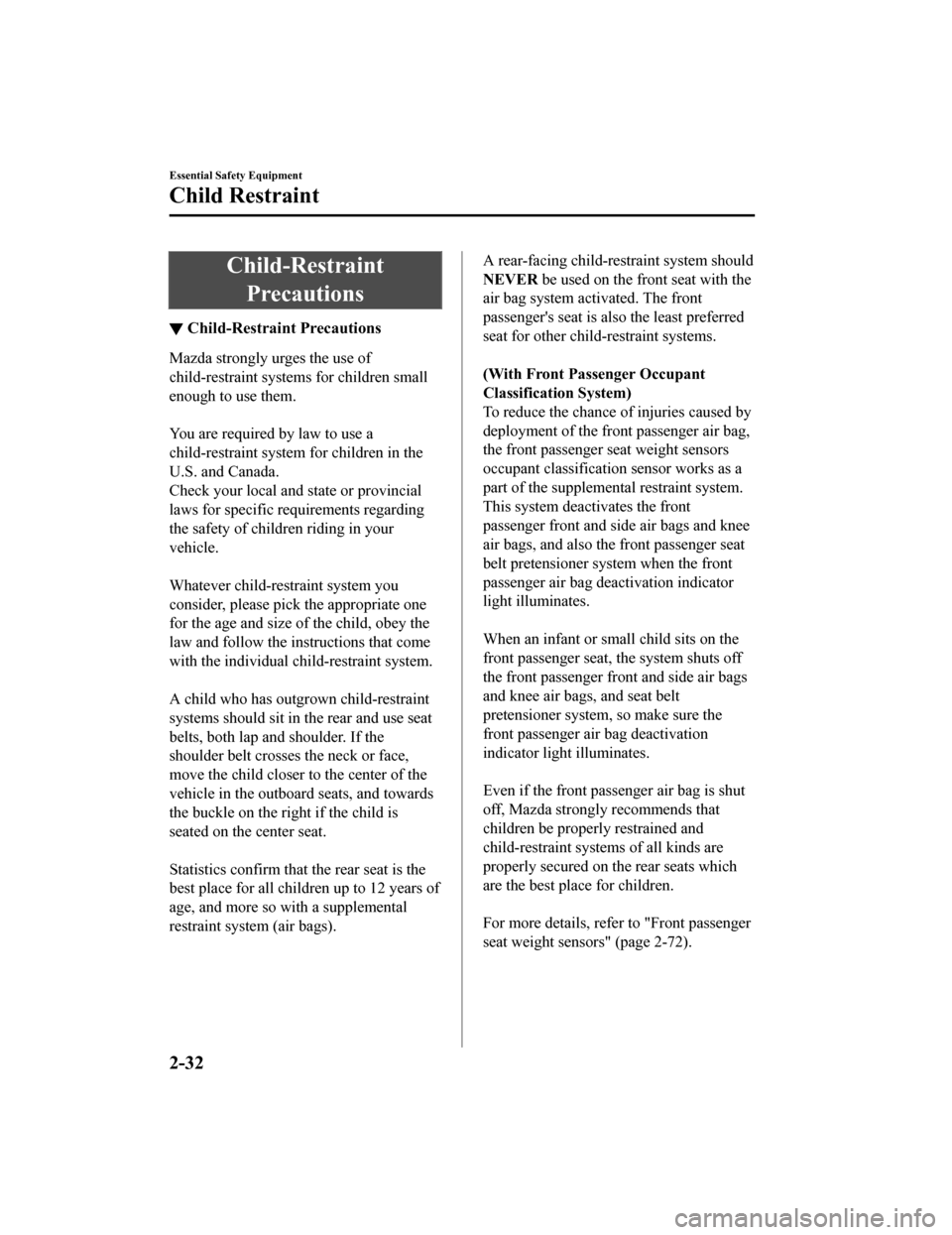
Child-RestraintPrecautions
▼ Child-Restraint Precautions
Mazda strongly urges the use of
child-restraint system
s for children small
enough to use them.
You are required by law to use a
child-restraint system for children in the
U.S. and Canada.
Check your local and state or provincial
laws for specific requirements regarding
the safety of childr en riding in your
vehicle.
Whatever child-rest raint system you
consider, please pick the appropriate one
for the age and size of the child, obey the
law and follow the i nstructions that come
with the individual ch ild-restraint system.
A child who has outgrown child-restraint
systems should sit in the rear and use seat
belts, both lap an d shoulder. If the
shoulder belt crosses the neck or face,
move the child closer to the center of the
vehicle in the outboard seats, and towards
the buckle on the right if the child is
seated on the center seat.
Statistics confirm that the rear seat is the
best place for all children up to 12 years of
age, and more so with a supplemental
restraint system (air bags).
A rear-facing child-restraint system should
NEVER be used on the front seat with the
air bag system activated. The front
passenger's seat is also the least preferred
seat for other child-restraint systems.
(With Front Passenger Occupant
Classification System)
To reduce the chance of injuries caused by
deployment of the front passenger air bag,
the front passenger seat weight sensors
occupant classification sensor works as a
part of the supplementa l restraint system.
This system deactivates the front
passenger front and side air bags and knee
air bags, and also the front passenger seat
belt pretensioner system when the front
passenger air bag deactivation indicator
light illuminates.
When an infant or small child sits on the
front passenger seat, the system shuts off
the front passenger front and side air bags
and knee air bags, and seat belt
pretensioner system, so make sure the
front passenger air bag deactivation
indicator light illuminates.
Even if the front passenger air bag is shut
off, Mazda strongly recommends that
children be prope rly restrained and
child-restraint systems of all kinds are
properly secured on the rear seats which
are the best place for children.
For more details, refer to "Front passenger
seat weight sensors" (page 2-72).
Essential Safety Equipment
Child Restraint
2-32
Mazda3_8HZ1-EA-19G_Edition1_old 2019-5-17 13:49:03
Page 50 of 598
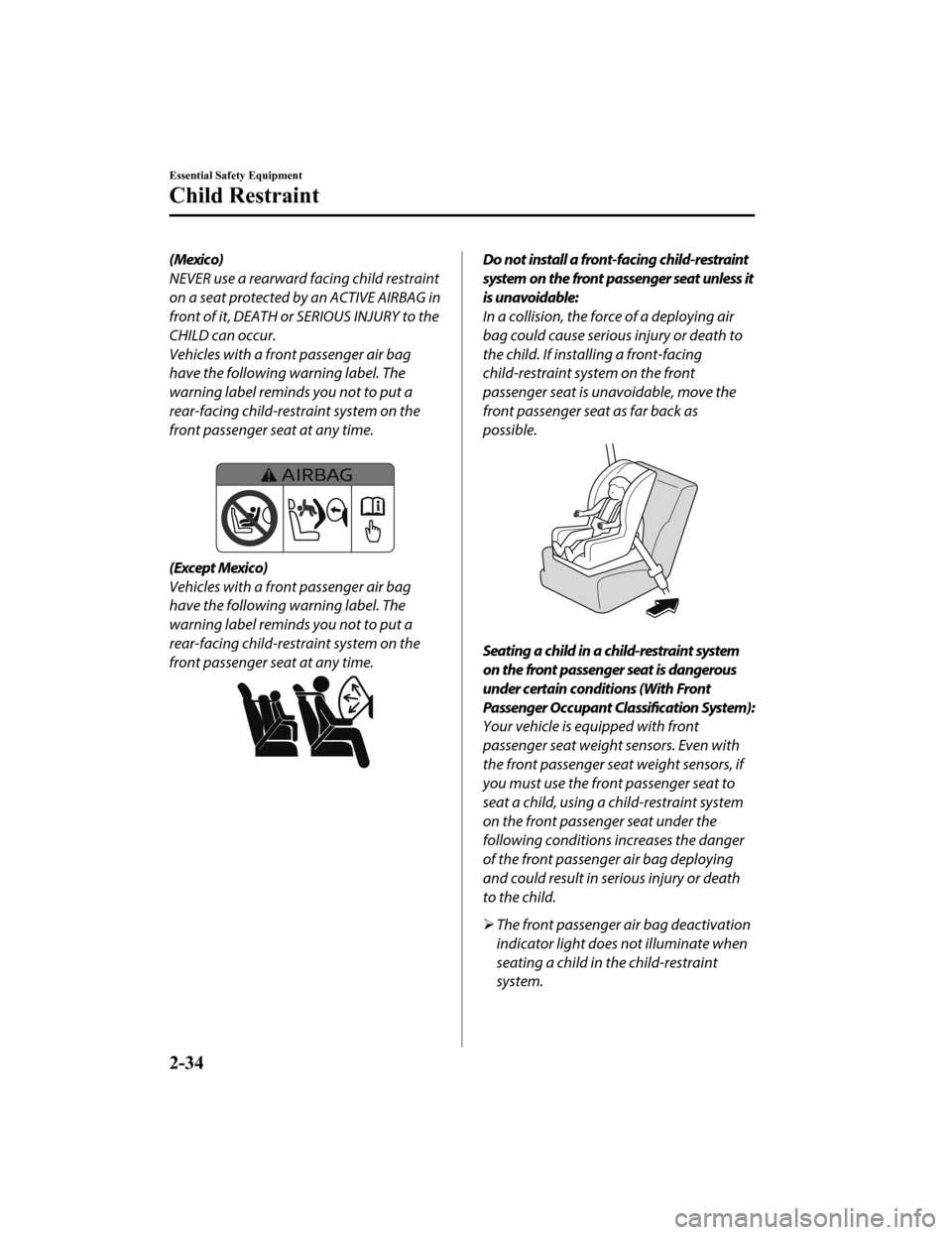
(Mexico)
NEVER use a rearward facing child restraint
on a seat protected by an ACTIVE AIRBAG in
front of it, DEATH or SERIOUS INJURY to the
CHILD can occur.
Vehicles with a front passenger air bag
have the following warning label. The
warning label reminds you not to put a
rear-facing child-restraint system on the
front passenger seat at any time.
(Except Mexico)
Vehicles with a front passenger air bag
have the following warning label. The
warning label reminds you not to put a
rear-facing child-restraint system on the
front passenger seat at any time.
Do not install a front-facing child-restraint
system on the front passenger seat unless it
is unavoidable:
In a collision, the force of a deploying air
bag could cause serious injury or death to
the child. If installing a front-facing
child-restraint system on the front
passenger seat is unavoidable, move the
front passenger seat as far back as
possible.
Seating a child in a child-restraint system
on the front passenger seat is dangerous
under certain conditions (With Front
Passenger Occupant Classification System):
Your vehicle is equipped with front
passenger seat weight sensors. Even with
the front passenger seat weight sensors, if
you must use the front passenger seat to
seat a child, using a child-restraint system
on the front passenger seat under the
following conditions increases the danger
of the front passenger air bag deploying
and could result in serious injury or death
to the child.
The front passenger air bag deactivation
indicator light does not illuminate when
seating a child in the child-restraint
system.
Essential Safety Equipment
Child Restraint
2-34
Mazda3_8HZ1-EA-19G_Edition1_old 2019-5-17 13:49:03
Page 51 of 598
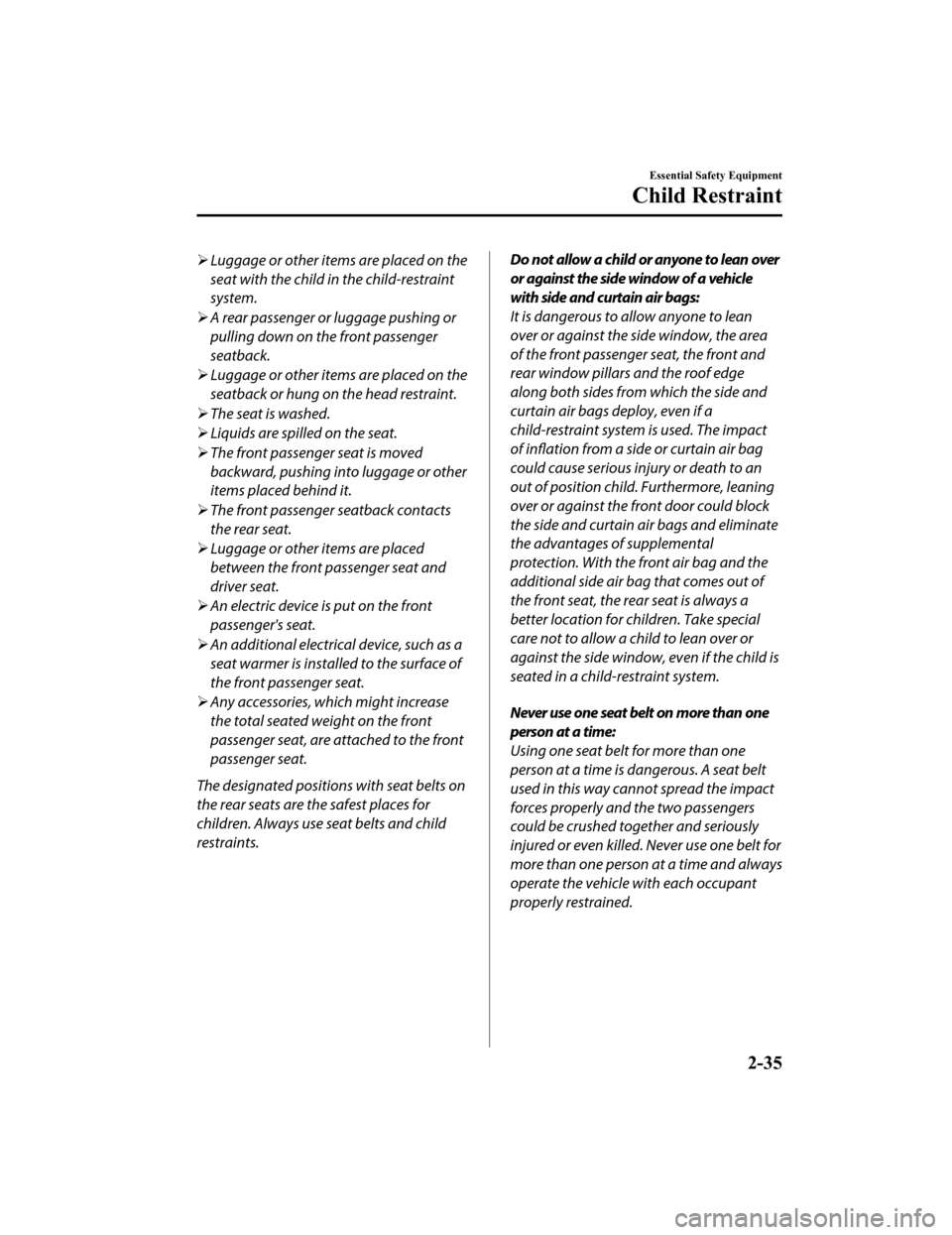
Luggage or other items are placed on the
seat with the child in the child-restraint
system.
A rear passenger or luggage pushing or
pulling down on the front passenger
seatback.
Luggage or other items are placed on the
seatback or hung on the head restraint.
The seat is washed.
Liquids are spilled on the seat.
The front passenger seat is moved
backward, pushing into luggage or other
items placed behind it.
The front passenger seatback contacts
the rear seat.
Luggage or other items are placed
between the front passenger seat and
driver seat.
An electric device is put on the front
passenger's seat.
An additional electrical device, such as a
seat warmer is installed to the surface of
the front passenger seat.
Any accessories, which might increase
the total seated weight on the front
passenger seat, are attached to the front
passenger seat.
The designated positions with seat belts on
the rear seats are the safest places for
children. Always use seat belts and child
restraints.Do not allow a child or anyone to lean over
or against the side window of a vehicle
with side and curtain air bags:
It is dangerous to allow anyone to lean
over or against the side window, the area
of the front passenger seat, the front and
rear window pillars and the roof edge
along both sides from which the side and
curtain air bags deploy, even if a
child-restraint system is used. The impact
of inflation from a side or curtain air bag
could cause serious injury or death to an
out of position child. Furthermore, leaning
over or against the front door could block
the side and curtain air bags and eliminate
the advantages of supplemental
protection. With the front air bag and the
additional side air bag that comes out of
the front seat, the rear seat is always a
better location for children. Take special
care not to allow a child to lean over or
against the side window, even if the child is
seated in a child-restraint system.
Never use one seat belt on more than one
person at a time:
Using one seat belt for more than one
person at a time is dangerous. A seat belt
used in this way cannot spread the impact
forces properly and the two passengers
could be crushed together and seriously
injured or even killed. Never use one belt for
more than one person at a time and always
operate the vehicle with each occupant
properly restrained.
Essential Safety Equipment
Child Restraint
2-35
Mazda3_8HZ1-EA-19G_Edition1_old 2019-5-17 13:49:03
Page 53 of 598

Child-Restraint System Installation
▼Categories of Child-Restraint Systems
NOTE
When purchasing, ask the manufacturer of the child-restraint system which type of
child-restraint system is appropriate for your child and vehicle.
(Mexico)
Child-restraint systems are clas
sified into the following 5 groups according to the UN-R 44
regulation.
Group Age WeightSize Classification/
Fixture (CRF)
0 Up to about 9 months old Up to 10 kg (up to 22 lb) ISO/L1
ISO/L2
ISO/R1
0+ Up to about 2 years old Up to 13 kg (up to 29 lb) ISO/R1
ISO/R2
ISO/R3
1 About 8 months to 4 years old 9 kg ― 18 kg (20 lb ― 40 lb) ISO/R2
ISO/R3
ISO/F2
ISO/F2X ISO/F3
2 About 3 to 7 years old 15 kg ― 25 kg (33 lb ― 55 lb) ―
3 About 6 to 12 years old 22 kg ― 36 kg (48 lb ― 79 lb) ―
(Except Mexico)
Please comply with the legal regulations concerning the use of child-restraint systems in
your country.
▼ Child-Restraint System Types
In this owner's manual, explanation of
child-restraint systems is provided for the
following three types of popular
child-restraint systems: infant seat, child
seat, booster seat.
NOTE
Installation position is determined by
the type of child-restraint system.
Always read the manufacturer's
instructions and this owner's manual
carefully.
Essential Safety Equipment
Child Restraint
2-37
Mazda3_8HZ1-EA-19G_Edition1_old
2019-5-17 13:49:03
Page 64 of 598
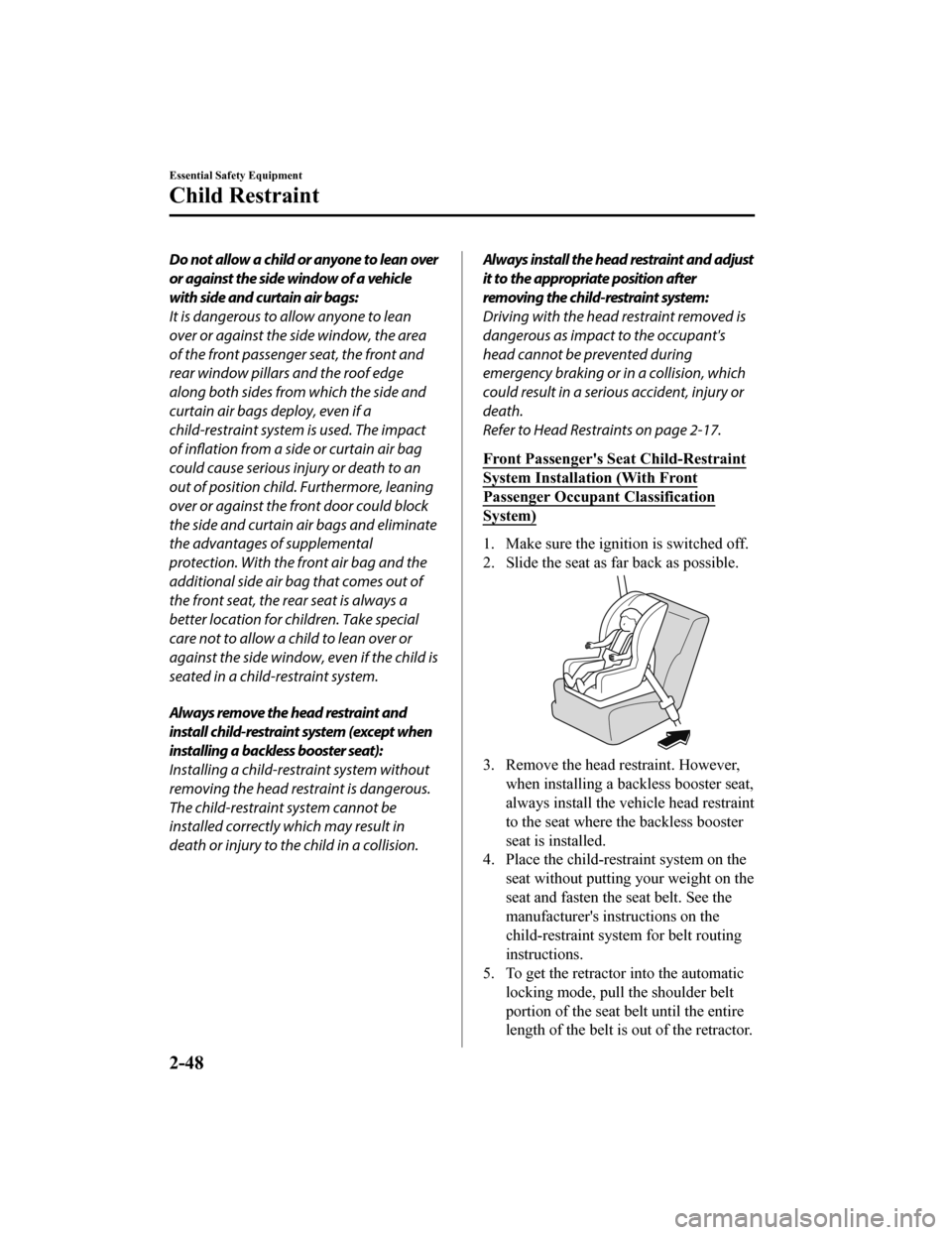
Do not allow a child or anyone to lean over
or against the side window of a vehicle
with side and curtain air bags:
It is dangerous to allow anyone to lean
over or against the side window, the area
of the front passenger seat, the front and
rear window pillars and the roof edge
along both sides from which the side and
curtain air bags deploy, even if a
child-restraint system is used. The impact
of inflation from a side or curtain air bag
could cause serious injury or death to an
out of position child. Furthermore, leaning
over or against the front door could block
the side and curtain air bags and eliminate
the advantages of supplemental
protection. With the front air bag and the
additional side air bag that comes out of
the front seat, the rear seat is always a
better location for children. Take special
care not to allow a child to lean over or
against the side window, even if the child is
seated in a child-restraint system.
Always remove the head restraint and
install child-restraint system (except when
installing a backless booster seat):
Installing a child-restraint system without
removing the head restraint is dangerous.
The child-restraint system cannot be
installed correctly which may result in
death or injury to the child in a collision.Always install the head restraint and adjust
it to the appropriate position after
removing the child-restraint system:
Driving with the head restraint removed is
dangerous as impact to the occupant's
head cannot be prevented during
emergency braking or in a collision, which
could result in a serious accident, injury or
death.
Refer to Head Restraints on page 2-17.
Front Passenger's Seat Child-Restraint
System Installation (With Front
Passenger Occupant Classification
System)
1. Make sure the ignition is switched off.
2. Slide the seat as fa r back as possible.
3. Remove the head restraint. However,
when installing a backless booster seat,
always install the vehicle head restraint
to the seat where the backless booster
seat is installed.
4. Place the child-restraint system on the
seat without putting your weight on the
seat and fasten the seat belt. See the
manufacturer's instructions on the
child-restraint syst em for belt routing
instructions.
5. To get the retractor into the automatic locking mode, pull the shoulder belt
portion of the seat belt until the entire
length of the belt is out of the retractor.
Essential Safety Equipment
Child Restraint
2-48
Mazda3_8HZ1-EA-19G_Edition1_old 2019-5-17 13:49:03
Page 75 of 598

Do not overload your vehicle:
Overloading your vehicle is dangerous as
it could prevent the air bag crash sensor
system from accurately detecting a
collision or roll-over accident resulting in
incorrect or unexpected air bag
deployment and the possibility of serious
injuries. The gross axle weight rating
(GAWR) and the gross vehicle weight
rating (GVWR) for your vehicle are on the
Motor Vehicle Safety Standard Label on
the driver's door frame. Do not exceed
these ratings.
Do not drive the vehicle off-road:
Driving your Mazda off-road is
dangerous because the vehicle has not
been designed to do so. Driving the
vehicle off-road could prevent the air bag
crash sensor system from accurately
detecting a collision or roll-over accident
resulting in incorrect or unexpected air
bag deployment and the possibility of
serious injuries.Do not modify a front door or leave any
damage unrepaired. Always have an
Authorized Mazda Dealer inspect a
damaged front door:
Modifying a front door or leaving any
damage unrepaired is dangerous. Each
front door has a side crash sensor as a
component of the supplemental restraint
system. If holes are drilled in a front door, a
door speaker is left removed, or a damaged
door is left unrepaired, the sensor could be
adversely affected causing it to not detect
the pressure of an impact correctly during a
side collision. If a sensor does not detect a
side impact correctly, the side and curtain
air bags and the front seat belt
pretensioner may not operate normally
which could result in serious injury to
occupants.
Do not modify the supplemental restraint
system:
Modifying the components or wiring of the
supplemental restraint system is
dangerous. You could accidentally activate
it or make it inoperable. Do not make any
modifications to the supplemental restraint
system. This includes installing trim,
badges, or anything else over the air bag
modules. It also includes installing extra
electrical equipment on or near system
components or wiring. An Authorized
Mazda Dealer can provide the special care
needed in the removal and installation of
front seats. It is important to protect the air
bag wiring and connections to assure that
the bags do not accidentally deploy, and
that the front passenger occupant
classification system and the seats retain
an undamaged air bag connection.
Essential Safety Equipment
SRS Air Bags
2-59
Mazda3_8HZ1-EA-19G_Edition1_old 2019-5-17 13:49:03
Page 78 of 598
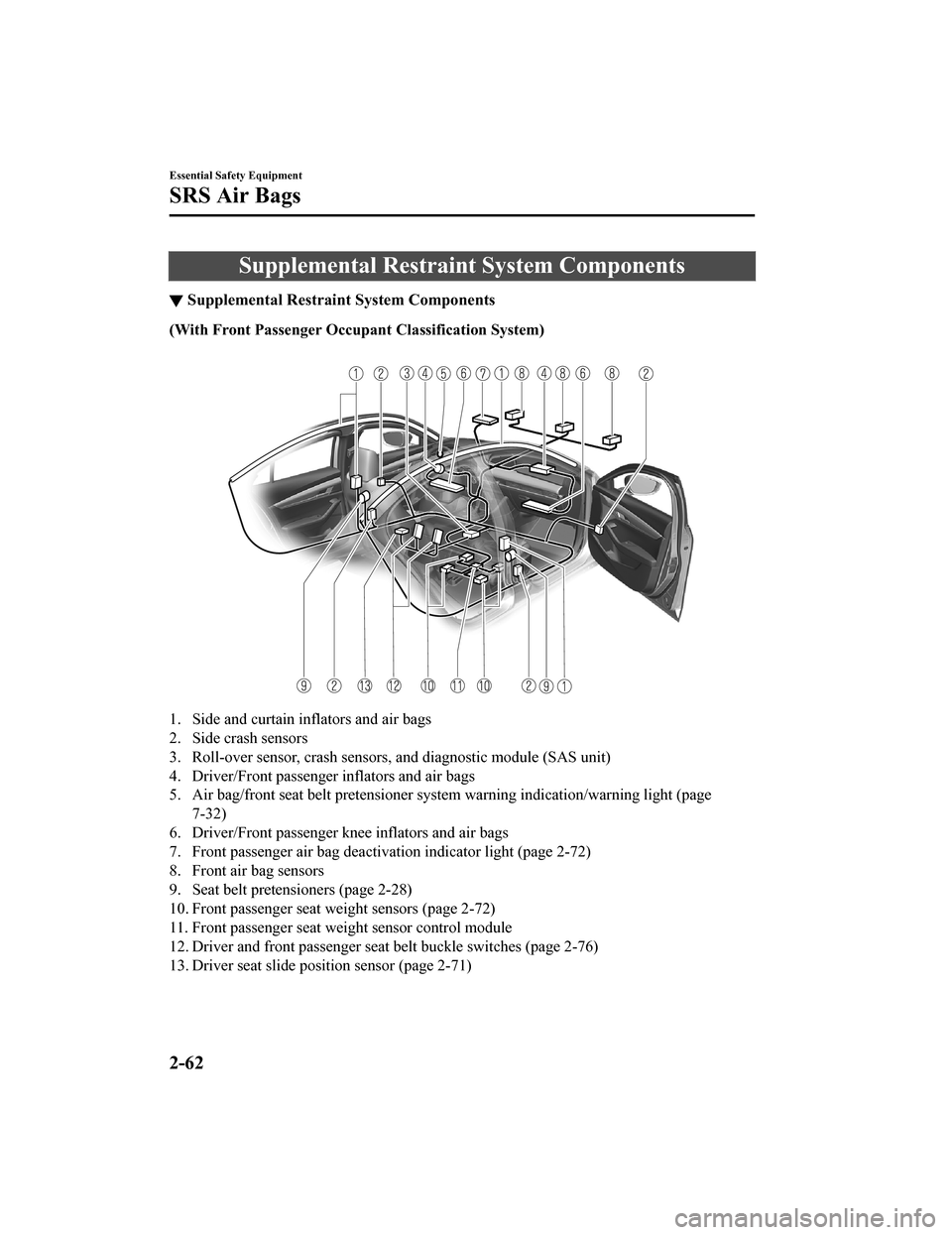
Supplemental Restraint System Components
▼Supplemental Restraint System Components
(With Front Passenger Occupa
nt Classification System)
1. Side and curtain inflators and air bags
2. Side crash sensors
3. Roll-over sensor, crash sensors, and diagnostic module (SAS u nit)
4. Driver/Front passenger inflators and air bags
5. Air bag/front seat belt preten sioner system warning indication/warning light (page
7-32)
6. Driver/Front passenger knee inflators and air bags
7. Front passenger air bag deactivation indicator light (page 2- 72)
8. Front air bag sensors
9. Seat belt pretensioners (page 2-28)
10. Front passenger seat wei ght sensors (page 2-72)
11. Front passenger seat weight sensor control module
12. Driver and front passenger seat belt buckle switches (page 2 -76)
13. Driver seat slide position sensor (page 2-71)
Essential Safety Equipment
SRS Air Bags
2-62
Mazda3_8HZ1-EA-19G_Edition1_old 2019-5-17 13:49:03
Page 81 of 598
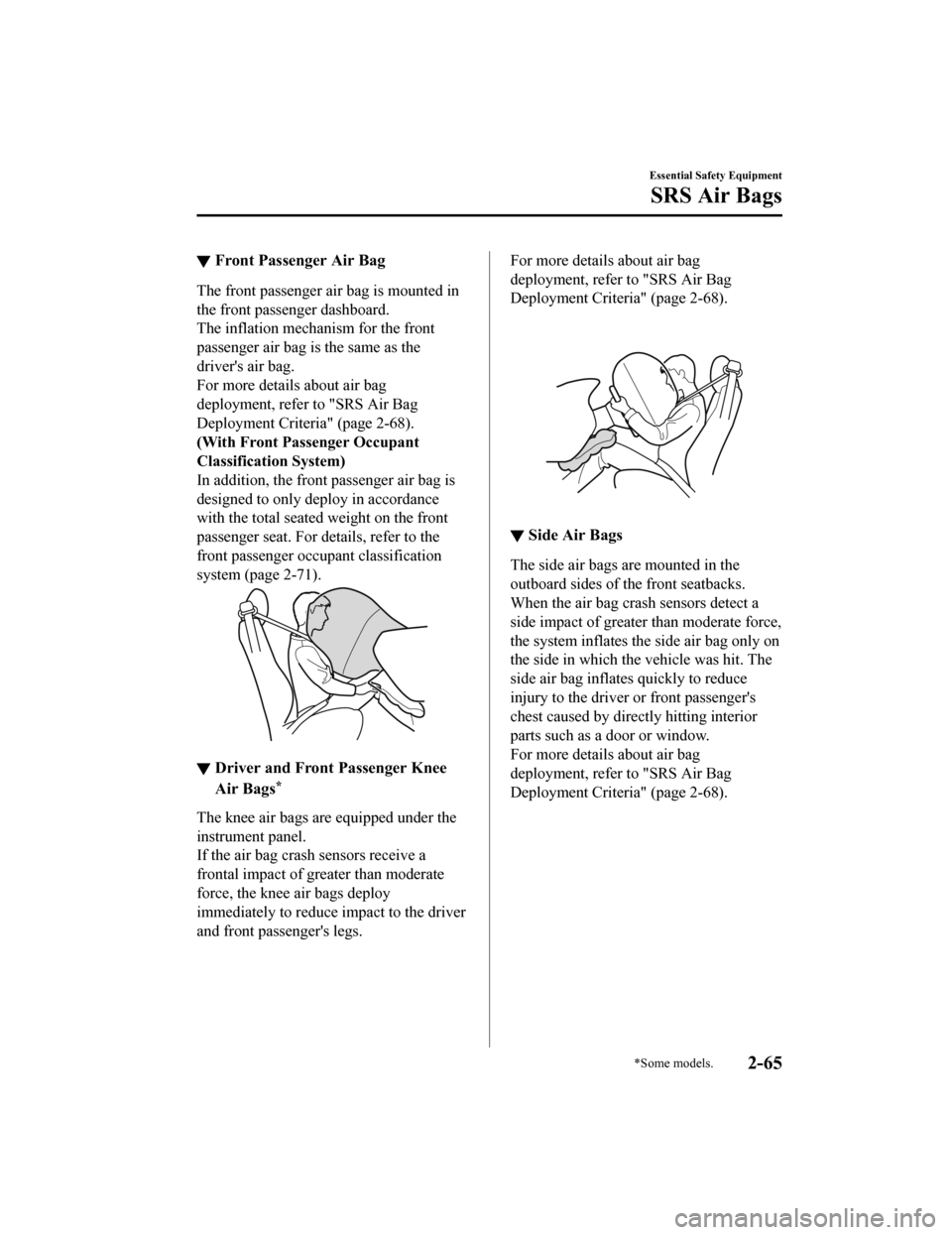
▼Front Passenger Air Bag
The front passenger air bag is mounted in
the front passenger dashboard.
The inflation mechanism for the front
passenger air bag is the same as the
driver's air bag.
For more details about air bag
deployment, refer to "SRS Air Bag
Deployment Crite
ria" (page 2-68).
(With Front Passenger Occupant
Classification System)
In addition, the front passenger air bag is
designed to only deploy in accordance
with the total seated weight on the front
passenger seat. For details, refer to the
front passenger occupant classification
system (page 2-71).
▼ Driver and Front Passenger Knee
Air Bags*
The knee air bags are equipped under the
instrument panel.
If the air bag crash
sensors receive a
frontal impact of greater than moderate
force, the knee air bags deploy
immediately to reduce impact to the driver
and front passenger's legs.
For more details about air bag
deployment, refer to "SRS Air Bag
Deployment Criteria" (page 2-68).
▼ Side Air Bags
The side air bags are mounted in the
outboard sides of the front seatbacks.
When the air bag crash sensors detect a
side impact of greater than moderate force,
the system inflates the side air bag only on
the side in which the vehicle was hit. The
side air bag inflates quickly to reduce
injury to the driver or front passenger's
chest caused by directly hitting interior
parts such as a door or window.
For more details about air bag
deployment, refer to "SRS Air Bag
Deployment Criteria" (page 2-68).
Essential Safety Equipment
SRS Air Bags
*Some models.2-65
Mazda3_8HZ1-EA-19G_Edition1_old
2019-5-17 13:49:03
Page 82 of 598
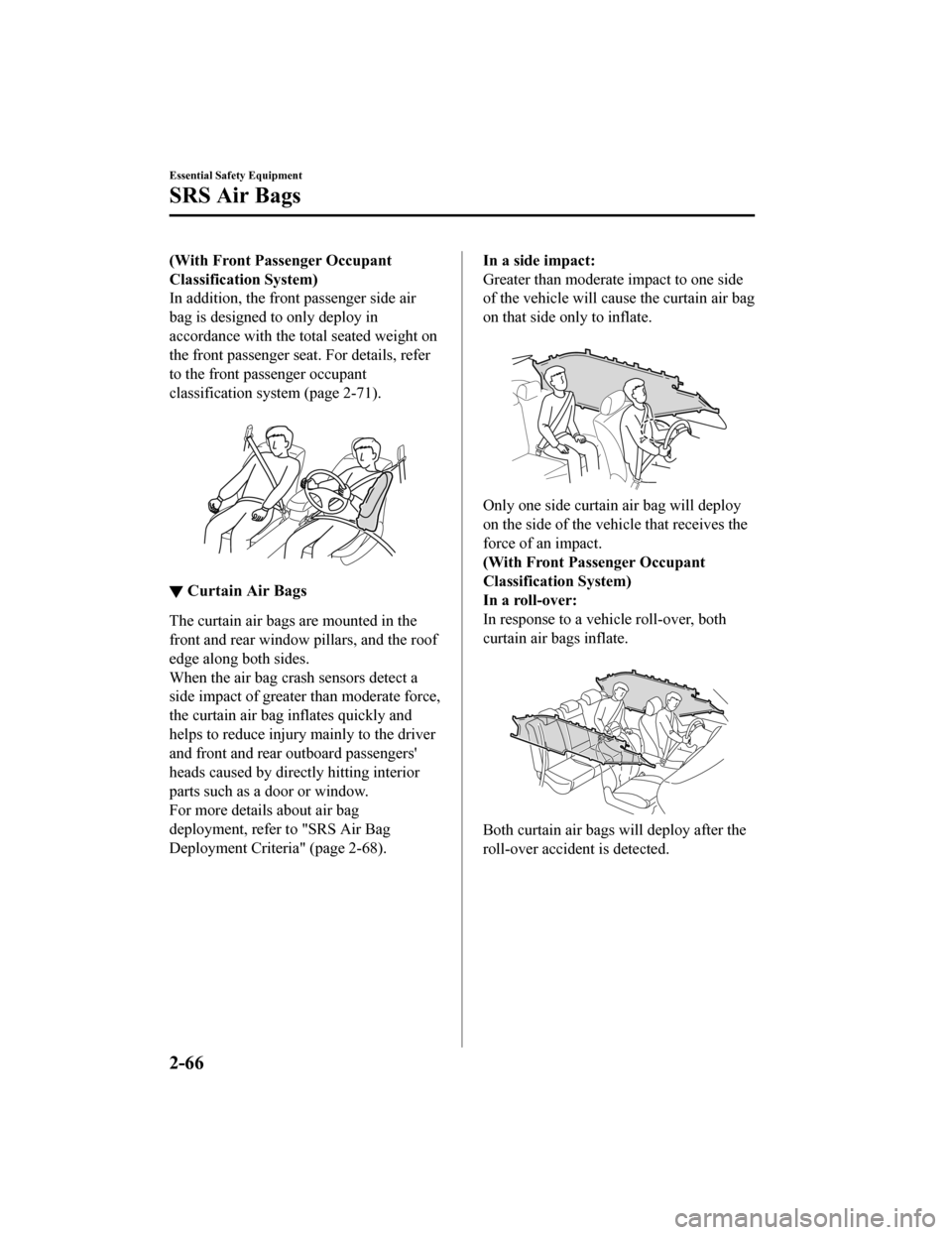
(With Front Passenger Occupant
Classification System)
In addition, the front passenger side air
bag is designed to only deploy in
accordance with the total seated weight on
the front passenger seat. For details, refer
to the front passenger occupant
classification system (page 2-71).
▼ Curtain Air Bags
The curtain air bags are mounted in the
front and rear window pillars, and the roof
edge along both sides.
When the air bag cra
sh sensors detect a
side impact of greater than moderate force,
the curtain air bag inflates quickly and
helps to reduce injury mainly to the driver
and front and rear outboard passengers'
heads caused by direct ly hitting interior
parts such as a door or window.
For more details about air bag
deployment, refer to "SRS Air Bag
Deployment Criteria" (page 2-68).
In a side impact:
Greater than moderate impact to one side
of the vehicle will cau se the curtain air bag
on that side only to inflate.
Only one side curtain air bag will deploy
on the side of the veh icle that receives the
force of an impact.
(With Front Passenger Occupant
Classification System)
In a roll-over:
In response to a vehicle roll-over, both
curtain air bags inflate.
Both curtain air bags will deploy after the
roll-over accident is detected.
Essential Safety Equipment
SRS Air Bags
2-66
Mazda3_8HZ1-EA-19G_Edition1_old 2019-5-17 13:49:03